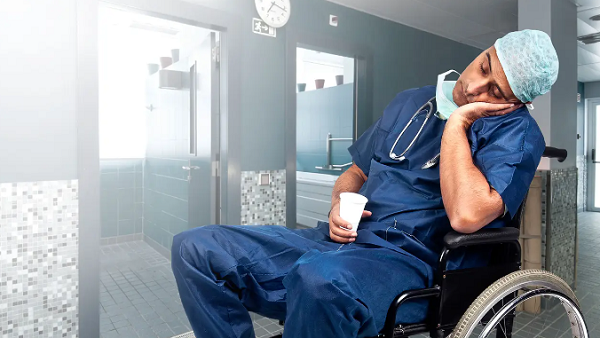The ED Remains Colored by Despair
by Edwin Leap, MD, Contributing Writer, MedPage
January 1, 2024
 In late 2022, Edwin Leap, MD, wrote about how emergency departments throughout the country were overburdened with patients and staffed with healthcare workers who were running out of steam. As part of our review of the past year’s biggest events, we asked Leap: what’s the situation like today? His response points to a similarly dire situation, but he highlights important progress from which healthcare workers can take solace.
In late 2022, Edwin Leap, MD, wrote about how emergency departments throughout the country were overburdened with patients and staffed with healthcare workers who were running out of steam. As part of our review of the past year’s biggest events, we asked Leap: what’s the situation like today? His response points to a similarly dire situation, but he highlights important progress from which healthcare workers can take solace.
With the worst of the COVID nightmare now behind us and the public health emergency ending in May, many of us hoped that the lessons of the pandemic would lead to positive changes in American healthcare — which might ease the situation in the overrun emergency department (ED). That didn’t materialize.
I suppose that if I had to use one word to describe the tone of the modern American emergency department, it would have to be “despair.”
Our patients continue to despair for many reasons. No small number do so because they inhabit a nightmarish loop that goes from home or nursing home, to hospital, to rehab. Rinse, repeat. They are too sick for any urgent care or primary care office, so they come to the ED where we plug them back into the system as before, knowing their names and medical histories as soon as we see their exhausted faces on the EMS stretchers. Once admitted they end up in uncomfortable rooms in the ED with complex illnesses, but no free beds for inpatient admission.
As research now suggests, a significant number of patients on “hold” simply die in our EDs. It’s the wrong place for the long-term care of complex problems. Just as awful, even if they are admitted they cannot be easily discharged because there are too few beds for them in nursing homes and rehab centers.
Even those with common, everyday problems despair as they wait hours to be treated for pneumonia or fracture, for dehydration or fever, for uncertain chest pain, only to be told to wait yet a little longer as the sickest of the sick continue to arrive via EMS and take up what few precious beds remain open in our departments, which are almost always at capacity.
Some of the very sick leave the waiting room out of sheer exhaustion; perhaps it’s best to suffer in your own bed rather than a stiff chair with someone coughing, hallucinating, or screaming next to you. A few of those who leave simply die at home because their illnesses were not immediately manifest to the harried triage staff.
Patients also despair because their illnesses are reflective of their often inescapable poverty. They struggle to clothe and feed their children in a difficult economy. Going to a primary care physician or any appointment is out of the question, lacking even the money for gasoline. The ED, often by ambulance, is their only outlet despite the fact that they don’t have “an emergency.” Well, not to us anyway; but certainly to them.
Far too many patients despair as a consequence of the unfathomable and uninterrupted volume of fentanyl, methamphetamine, and other substances flooding our streets and devastating human life. The breathless, the blue-lipped, and pale become routine visitors to modern EDs, and naloxone becomes as essential as air.
Likewise, the mentally ill have desperate thoughts and situations, their families at wit’s end (if they are still connected in any way). They bring their pain and confusion to the ED, or are brought by police, EMS, or loved ones, frantic for help. The number of those diagnosed with mental illness, coupled with those who should be, is made worse by the lack of experts to help them, hospital beds to receive them, or money to fund their treatment. These afflictions descend to the youngest of our patients, as shocking numbers of children report suicidal intent. Sometimes our psychiatric patients just weep or scream in locked rooms where we “hold” them.
There’s more to say. There’s violence, domestic violence, human trafficking, and drug shortages. There is the financial devastation of serious illness. There’s even the despair that can come from insufficient availability of ambulances for 911 calls or transfers. I recall caring for a patient in a remote rural hospital, who had a myocardial infarction and needed to be transferred. We had limited ambulances for transfer. His fretful spouse asked, “What do you mean there’s no ambulance?” It’s hard to explain that sort of scarcity.
Even worse than the inadequacy of ambulance availability, this year we have seen growing threats to the existence of rural hospitals, as hundreds are in danger of closure.
[READ FULL ARTICLE HERE]
